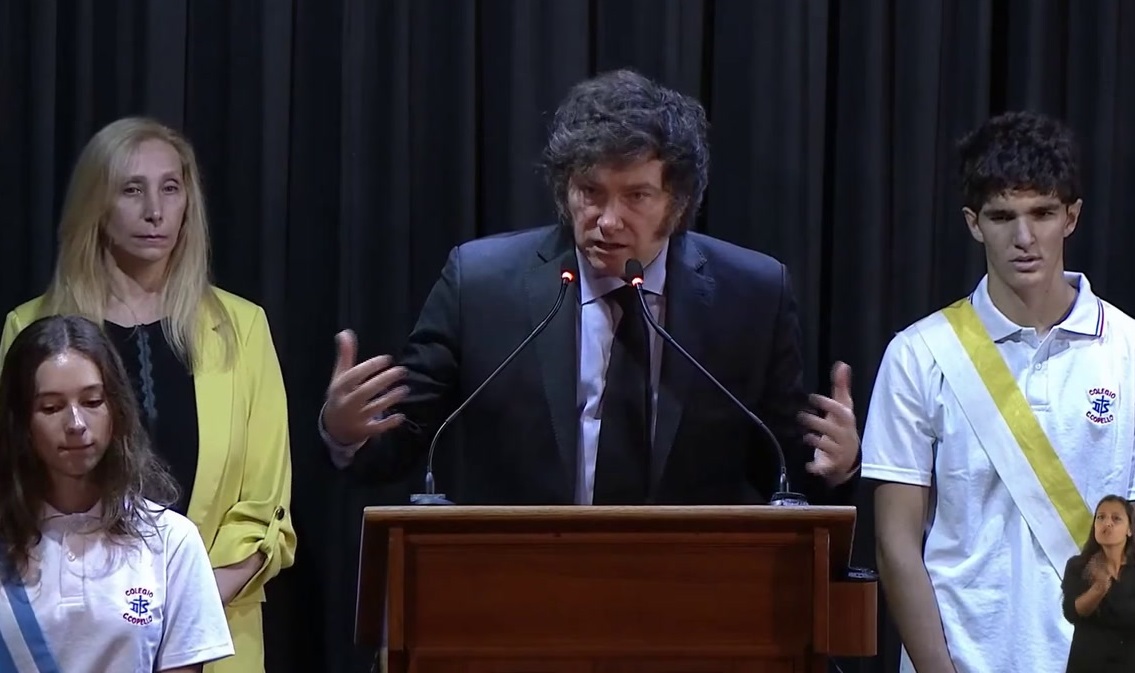
And fainted teenager, a president who mocks. It happens at the Cardenal Copello school on a Wednesday. The scene compresses the contradictions of a country that is going through the anguish of the crisis. The unpleasantness of an adjustment that he did not choose, but – in part and only for the moment – seems to tolerate, waiting for an “economic miracle” that does not and will not arrive.
If Alberto Fernández was the president meme for its absolute capacity to summon ridicule, Javier Milei is the bullying president. If the first symbolically condensed the state’s ineffectiveness in the face of a country in decline, the second anger concentrates at the persistence of the crisis. Rage catalyzed into hatred and contempt for others; impotent fury vomited out in screams and insults.
Beyond his infuriating personality, Milei is forced to be harassed and publicly harassed: he is in the political nature of his character. Running a systematic bullying Try to empathize with that portion of the population that lives in disenchantment. That she anguishedly awaits a solution to the evils inherited from Macrista and Peronist times.
Paradoxically, That anguish grows with every hour of mileista management. It increases in line at the supermarket, in the anxious calculation about whether or not there will be enough money to pay for what the little monkey carries. In the bitter wait for a telegram or notice of dismissal. In the sad image of empty businesses, open to hypothetical buyers who will possibly repeat “I’m just looking.”
But the call social tolerance to adjustment has a weak character, brittle. Sooner or later it will turn into disappointment with the current government cast. In doing so, it will operate as a starting point for a new mass resistance. He strategic problem es prepare the paths and contours of that resistance. Build the scenarios and tools to that the worker and popular mobilization is not led to the impotent and increasingly dramatic path of a “There is 2027”, but rather opens the possibility of categorical triumphs of the revolutionary mass mobilization.
The art of disarming resistance
He political-union apparatus of Peronism exercises the ancient art of disarming any resistance.
The union organizations renounce the unitary fight against the adjustment plan. Faced with the global offensive of the Line Army led by Milei, the IMF and big capital, the CGT and CTA rehearse something that slightly refers to a “guerilla war”. Pablo Moyano and Héctor Daer threaten with a new national strike that they do not stop postponing. Thus they dismiss the social strength of the working class, that human power capable of paralyzing the country’s economic activity. The Peronist and Kirchnerist social organizations They do not offer a different course: they limit their fight to facing the savage adjustment that falls on soup kitchens and social assistance.
He political peronism It emits constant creaking noises. The media arena stages cross accusations. Each fraction prioritizes its sectoral interests. Cristina Kirchner -after offering a platform aimed at agreeing on the adjustment- returns to the art of amalgamating politics and nostalgia, remembering his presidential efforts. In this stage, Kicillof and Grabois They present themselves as apparent heads of a resistance that knows no other method than words. At the same time, the governor executes the adjustment in the province he administers.
In this disorganizing work, the political peronism chooses to ignore the neighborhood assemblies. The presence of Peronist and Kirchnerist militancy speaks more of individual desire and will than of a general orientation.
Leadership in times of crisis
In the first pages of his latest book, Henry Kissinger wrote that “a leader is forced to navigate within a narrow margin, suspended between the relative certainties of the past and the ambiguities of the future” [1].
Milei presents himself to society as a leader willing to pay the “political cost” for the transformations he proposes. In that perspective, he offers the country a new destiny: a supposed power Argentina, which leaves behind the decadence that the “caste model” would have engendered. With this objective, he calls on the population to endure the suffering that would accompany the transformation.
But his virulent rhetoric finds almost insurmountable limits in social reality. Past, present and future They appear before him full of uncertainty. Faced with the official adjustment, provincial powers, with leaders little inclined to assume the cost of cuts that also apply. There are also sectors of the business community affected by the violent nature of economic measures. Finally, it stands a social relationship of forces with broad layers of the working class and the poor that, even initially, begin to express their resistance.
From this complex network are born the dialogue essays, like the one staged this Friday with the governors. There, according to the first statements, he began a give and take that will last over time. They will negotiate adjustment quotas behind the backs of the working people. Nobody can predict success for that bagel.
He Milei’s leadership offers more appearance than substance. It emerges in unresolved tensions between political, social and institutional actors. It condenses a widespread social unrest that is channeled, partially, as support for his figure. It is destined to become extinct; to be consumed as the impossibility of the “economic spill” proposed by the official story becomes evident.
They are alternative is to defeat the resistance social; impose a tougher political order, conservative and reactionary. Preventing that outcome is an essential task of the period to come.
The force of the streets, the forces of the earth
A crowd of women filled the streets surrounding the National Congress. He marched, with force, through the people of Mar del Plata. He also made himself felt in Córdoba, Mendoza, Neuquén and Salta. He green and the violent They flooded cities. Massiveness defied repressive threats; responded to official misogyny in reality; announced that he will resist attacks on his rights.
The crowd of women contrasted, in fact, with the presence of the governors in Casa Rosada. He palace served as headquarters for the thread of adjustment. Las streets as a scene of confrontation with a large part of the official agenda.
The Mileist Government has been in office for just three months. He short period bears the marks of several massive mobilizations; and national strike of the CGT and the CTA; almost a week of fight against the Omnibus Law and resistance to Bullrich’s repression; days of guilds like aeronautical, railway, educational and health; multiple marches and cuts against closures and layoffs; mobilizations against cuts in soup kitchens. The protagonists are diverse, varied. They converge in opposition to the derivations of savage adjustment. It is urgent transform that simultaneity into unified combat.
Las earth forces can be enhanced from the joint battle against the official war plan. Get stronger from a democratic organization from below, which allows everyone to become an active protagonist in the fight. He enormous value of neighborhood assemblies lies there: creating a new type of political participation, They offer an example to follow in places of work and study; in unions and student centers; in every neighborhood and city. The PTS-Left Front promotes them in that perspective: a bet on widely motorize self-organization. Solo This dynamic can break the conservative inertia of bureaucratic apparatuses who bet on controlled mobilizations and pacts with those in power.
The collective mass struggle can open a horizon of hope. Break skepticism and resignation. Offer the best counterbalance to bullying that arises from despondency and daily anguish.
[1] Leadership, Six studies on global strategy; p.13.
Source: www.laizquierdadiario.com

